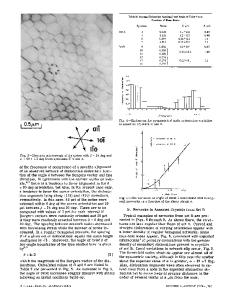Dislocation Boundaries and Slip Systems in Uniaxially Deformed Crystals
- PDF / 810,287 Bytes
- 6 Pages / 612 x 792 pts (letter) Page_size
- 74 Downloads / 432 Views
Dislocation Boundaries and Slip Systems in Uniaxially Deformed Crystals Grethe Winther, Xiaoxu Huang, Søren Fæster Nielsen and John Wert Materials Research Department, Risø National Laboratory, P.O. Box 49, DK-4000 Roskilde, Denmark ABSTRACT The dislocations in the extended planar dislocation boundaries formed during deformation are generated by the active slip systems. Investigation of the boundaries is therefore a tool to obtain information on the active slip systems. Here, the orientation of the dislocation boundaries in uniaxially deformed aluminum poly- and single crystals are compared. It is found that the single crystal boundary planes are consistent with those found in polycrystals, indicating that the active slip systems in single and polycrystals are the same. However, boundaries are closer to the slip planes in the single crystals. This is taken as an indication that the secondary slip systems are more active in the polycrystal. The orientation of the boundary plane varies with the crystal orientation in a way that is consistent with activation of the five most stressed slip systems. INTRODUCTION The extended planar dislocation boundaries found in uniaxially deformed single crystals are most often characterized by their relationship to the active slip planes. Many crystals – especially those with single or double slip – form boundaries that are parallel or almost parallel to the slip planes. When the crystals are oriented for multislip in tension the extended planar boundaries are either far from the slip planes ( parallel to the tensile axis) or do not form any extended boundaries but only a cell structure ( parallel to the tensile axis) [1]. Recently, Winther and coworkers [2] conducted a study of the relationship between boundary planes and slip planes in tensile deformed polycrystalline aluminum. It was found that the boundaries lie on different crystallographic planes depending on the crystallographic grain orientation as shown in figure 1. Except in grains with the tensile axis near , boundaries were rotated up to 10° away from the slip planes around axes perpendicular to the Burgers vectors of the active slip systems. Near the corner of the stereographic triangle the boundaries deviated more than 10° from the slip planes but no definite rotation axes could be detected due to an insufficient number of data points. The aim of the present contribution is to investigate the relationship between boundary planes and active slip systems in aluminum single crystals. This relationship is then compared to those found for the polycrystal. Comparison of the dislocation boundaries in the single and polycrystal allows some conclusions to be drawn about the similarity between the active slip systems in single and polycrystals. Single crystals with the [110] axis parallel to the deformation axis were selected and deformed in both tension and compression. The single crystals break up into bands which are hundreds of micrometers wide and thus allow investigation of the structures in crystal domains that have had dif
Data Loading...









